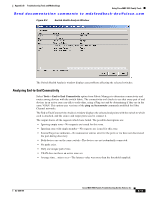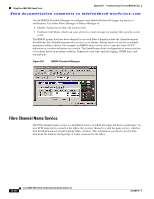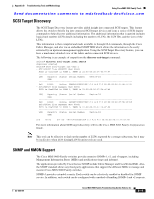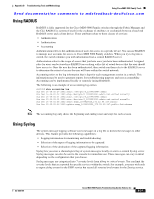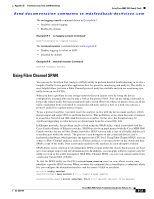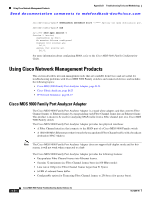Cisco MDS-9124 Troubleshooting Guide - Page 536
Events, Threshold Manager
 |
View all Cisco MDS-9124 manuals
Add to My Manuals
Save this manual to your list of manuals |
Page 536 highlights
Using Cisco MDS 9000 Family Tools Appendix B Troubleshooting Tools and Methodology Send documentation comments to [email protected] Note During initial configuration of your switch, the system prompts you to define SNMP v1 or V2 community strings and to create a SNMP v3 username and password. Cisco MDS 9000 Family switches support over 50 different MIBs, which can be divided into the following six categories: • IETF Standards-based Entity MIBs (for example, RFC273 ENTITY-MIB) These MIBs are used to report information on the physical devices themselves in terms of physical attributes etc. • Cisco-Proprietary Entity MIBs (for example, CISCO-ENTITY-FRU-CONTROL-MIB) These MIBs are used to report additional physical device information about Cisco-only devices such as their configuration. • IETF IP Transport-oriented MIBs (for example, RFC2013 UDP-MIB) These MIBs are used to report transport-oriented statistics on such protocols as IP, TCP, and UDP. These transports are used in the management of the Cisco MDS 9000 Family through the OOB Ethernet interface on the Supervisor module. • Cisco-Proprietary Storage and Storage Network MIBs (for example, NAME-SERVER-MIB) These MIBs were written by Cisco to help expose information that is discovered within a fabric to management applications not connected to the fabric itself. In addition to exposing configuration details for features like zoning and Virtual SANs (VSANs) via MIBs, discovered information from sources like the FC-GS-3 Name Server can be pulled via a MIB. Additionally, MIBs are provided to configure/enable features within the Cisco MDS 9000 Family. There are over 20 new MIBs provided by Cisco for this information and configuration capability. • IETF IP Storage Working Group MIBs (for example, ISCSI-MIB) While many of these MIBs are still work-in-progress, Cisco is helping to draft such MIBs for protocols such as iSCSI and Fibre Channel-over-IP (FCIP) to be standardized within the IETF. • Miscellaneous MIBs (for example, SNMP-FRAMEWORK-MIB) There are several other MIBs provided in the Cisco MDS 9000 Family switches for tasks such as defining the SNMP framework or creating SNMP partitioned views. You can use SNMPv3 to assign different SNMP capabilities to specific roles. Cisco MDS 9000 Family switches also support Remote Monitoring (RMON) for Fibre Channel. RMON provides a standard method to monitor the basic operations of network protocols providing connectivity between SNMP management stations and monitoring agents. RMON also provides a powerful alarm and event mechanism for setting thresholds and sending notifications based on changes in network behavior. The RMON groups that have been adapted for use with Fibre Channel include the AlarmGroup and the EventGroup. The AlarmGroup provides services to set alarms. Alarms can be set on one or multiple parameters within a device. For example, you can set an RMON alarm for a specific level of CPU utilization or crossbar utilization on a switch. The EventGroup lets you configure events that are actions to be taken based on an alarm condition. The types of events that are supported include logging, SNMP traps, and log-and-trap. Note To configure events within an RMON group, use the Events > Threshold Manager option from Device Manager. See the "Device Manager: RMON Threshold Manager" section on page B-17. B-20 Cisco MDS 9000 Family Troubleshooting Guide, Release 3.x OL-9285-05



